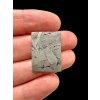Meteorite Toluca – Mexico
Typ: iron / IAB-sLL
Locality: Mexico
Weight: 4,9g
Dimensions: 24 x 18 x 1 mm
Year of found: 1776
Total known weight: 3 tonnes
Surface treatment: cut, polished slice; treated with oil
Toluca is an iron meteorite belonging to the group of so-called octahedrites, specifically to the chemical group IAB, and it falls within the sLL subgroup (Low-Au, Low-Ni), meaning it contains lower amounts of gold and nickel compared to other IAB meteorites. Nevertheless, it retains a sufficiently high content of iron and other metals to give it a distinctive metallic silver sheen. When etched and polished, it reveals the so-called Widmanstätten patterns – characteristic crystalline structures that form during extremely slow cooling of the metal in space. Due to its high iron content, Toluca is very heavy, so even a relatively small fragment can have a surprisingly large weight. In addition to iron and nickel, it also contains minor amounts of other minerals such as graphite or troilite, which occasionally form small inclusions in the material.
The meteorite was discovered in the Toluca Valley in central Mexico, from which it takes its name. Local people had known about the iron fragments long before the arrival of Europeans and used them, for example, to make tools. The first European mention of the meteorite dates back to 1776. To this day, smaller fragments can still be found in the area, as the original body broke apart into many pieces during its passage through the atmosphere.
Like most iron meteorites, Toluca probably originated during the formation of the solar system, approximately 4.5 billion years ago. At that time, a number of smaller proto-planetary bodies, called planetesimals, were moving through interplanetary space. These objects eventually failed to become full-fledged planets. Many of them had metallic cores formed by the segregation of heavier elements – primarily iron and nickel – into their central regions.







